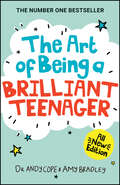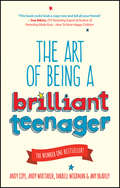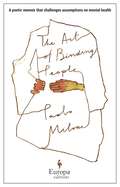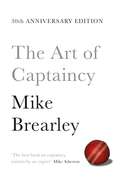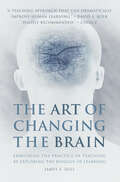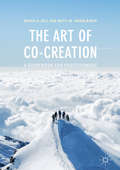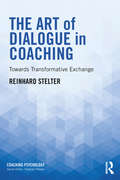- Table View
- List View
The Art of BART: Bilateral Affective Reprocessing of Thoughts as a Dynamic Model for Psychotherapy
by Arthur G. O'MalleyThe Art of BART (the Bilateral Affective Reprocessing of Thoughts) is a practitioner's introduction to an innovative psychotherapy model that draws on and integrates well-proven therapies (such as EMDR, sensorimotor psychotherapy and CBT) and on the Indian chakra tradition and other historical beliefs. As a therapeutic approach it has particular relevance to those who are living with the consequences of a traumatic event and those who seek after peak performance in fields such as sport and the arts. The book introduces the reader to BART as a psychotherapy that can benefit patients with disorders such as anorexia nervosa and dissociative identity disorder, and those who have suffered a traumatic event. It also looks at the information processing of the mind-body at the levels of the gut heart and the gut brain, and it makes connections between the endocrine and immune systems and the chakras of Indian tradition.
The Art of Being A Brilliant Teenager
by Andy Cope Amy BradleyThe BESTSELLING book on BEING A TEEN, now updated into an all new edition. In a world where there’s a lot of talk about ‘living your best life’ and being your ‘best self’, The Art of Being a Brilliant Teenager shows you how. The book has a strong academic underpinning (its DNA is taken from the author’s PhD) but is written in a fun and non-patronising way. The Art of Being a Brilliant Teenager is a book that prepares young people for REAL life; addressing modern issues of screen time and social media, as well as the teenage perennials of confidence, positivity, motivation and relationships. The book is built on a rock-solid foundation of wellbeing and human flourishing but is quirky in tone and entertaining to read. Dr Andy Cope’s words are brilliantly brought to life by award winning illustrator, Amy Bradley. The book includes activities and thought-provoking questions that encourage the user to interact with the material. Reflecting and journalling helps make the messages stick. Learn how to: Stay upbeat in a fast-paced world Be resilient and rise to life’s challenges Create strong relationships Conquer anxiety Tap into your values and use them to guide your life Shape your future The book has a deliberately light touch but is not light-weight. It doesn’t dodge the issues. In a world of rising anxiety, The Art of Being a Brilliant Teenager provides a personal upgrade to ‘world class’. It shows young people how to let go of bad habits and develop positive traits that will fire up their future. It covers themes of resilience, values, consumerism, purpose and communication, in a page-turning way. The Art of Being a Brilliant Teenager is THE go-to book to ease young people into adulthood.
The Art of Being A Brilliant Teenager
by Andy Cope Amy BradleyThe BESTSELLING book on BEING A TEEN, now updated into an all new edition. In a world where there’s a lot of talk about ‘living your best life’ and being your ‘best self’, The Art of Being a Brilliant Teenager shows you how. The book has a strong academic underpinning (its DNA is taken from the author’s PhD) but is written in a fun and non-patronising way. The Art of Being a Brilliant Teenager is a book that prepares young people for REAL life; addressing modern issues of screen time and social media, as well as the teenage perennials of confidence, positivity, motivation and relationships. The book is built on a rock-solid foundation of wellbeing and human flourishing but is quirky in tone and entertaining to read. Dr Andy Cope’s words are brilliantly brought to life by award winning illustrator, Amy Bradley. The book includes activities and thought-provoking questions that encourage the user to interact with the material. Reflecting and journalling helps make the messages stick. Learn how to: Stay upbeat in a fast-paced world Be resilient and rise to life’s challenges Create strong relationships Conquer anxiety Tap into your values and use them to guide your life Shape your future The book has a deliberately light touch but is not light-weight. It doesn’t dodge the issues. In a world of rising anxiety, The Art of Being a Brilliant Teenager provides a personal upgrade to ‘world class’. It shows young people how to let go of bad habits and develop positive traits that will fire up their future. It covers themes of resilience, values, consumerism, purpose and communication, in a page-turning way. The Art of Being a Brilliant Teenager is THE go-to book to ease young people into adulthood.
The Art of Being a Brilliant Teenager
by Andy Whittaker Andy Cope Darrell Woodman Amy BradleyCalling all teenagers—quit the moaning and start loving life! Don't be a cliché. Don't stay in your bedroom grunting and grumbling. How about getting motivated, energized and start making a difference?! The Art of Being A Brilliant Teenager teaches you how to become your very best self—and how to figure out who that is, exactly. The bestselling authors of The Art of Being Brilliant and Be Brilliant Everyday are experts in the art of happiness and positive psychology and, with this new book, you'll find your way to becoming brilliant at school, work, and life in general. Stay cool under all the pressures you're facing, and plot a map for the future that takes you wherever it is you want to go. Become proactive, determined, successful and most importantly: happy! Fact: your life span is about four thousand weeks. It seems like a lot, but it's not. Complaining about life, homework, parents, and relationships may be normal now, but don't let it become your defining trait. When you're forty years old and still moaning, a big chunk of your four thousand weeks have slipped by, and you're no closer to happiness than you were as a teen. This book is a guide to starting the journey to your ideal life now, instead of wasting time being a drip. Discover the real you, and what you want out of life Stop moaning and get moving now, while there's plenty of time Lose your bad habits before they become your personality Figure out how you want to contribute, and find a way to do it The bottom line is this: it's easy to be the average version of yourself, but is that really all you want? Don't you want to achieve something? Get started now. The Art of Being A Brilliant Teenager helps you figure out where you want to go, and how to get there. So, whether you're an ambitious teenager, a parent or teacher desperate to turn a down-beat teenager into a ray of positivity and delight, How to Be a Brilliant Teenager is here to help.
The Art of Being a Brilliant Teenager
by Andy Whittaker Andy Cope Darrell Woodman Amy BradleyCalling all teenagers—quit the moaning and start loving life! Don't be a cliché. Don't stay in your bedroom grunting and grumbling. How about getting motivated, energized and start making a difference?! The Art of Being A Brilliant Teenager teaches you how to become your very best self—and how to figure out who that is, exactly. The bestselling authors of The Art of Being Brilliant and Be Brilliant Everyday are experts in the art of happiness and positive psychology and, with this new book, you'll find your way to becoming brilliant at school, work, and life in general. Stay cool under all the pressures you're facing, and plot a map for the future that takes you wherever it is you want to go. Become proactive, determined, successful and most importantly: happy! Fact: your life span is about four thousand weeks. It seems like a lot, but it's not. Complaining about life, homework, parents, and relationships may be normal now, but don't let it become your defining trait. When you're forty years old and still moaning, a big chunk of your four thousand weeks have slipped by, and you're no closer to happiness than you were as a teen. This book is a guide to starting the journey to your ideal life now, instead of wasting time being a drip. Discover the real you, and what you want out of life Stop moaning and get moving now, while there's plenty of time Lose your bad habits before they become your personality Figure out how you want to contribute, and find a way to do it The bottom line is this: it's easy to be the average version of yourself, but is that really all you want? Don't you want to achieve something? Get started now. The Art of Being A Brilliant Teenager helps you figure out where you want to go, and how to get there. So, whether you're an ambitious teenager, a parent or teacher desperate to turn a down-beat teenager into a ray of positivity and delight, How to Be a Brilliant Teenager is here to help.
The Art of Binding People: A poetic memoir that challenges assumptions on mental health
by Paolo MiloneWe often speak of doctors as heroes, martyrs, or victims. Drawing from forty years of experience on an emergency psychiatric ward, Paolo Milone offers a more complex—and more compelling—picture. He transports us inside Ward 77, where mental illness coexists with the ordinary lives of those who, at the end of their shifts, take their white coats off. In this unsettling, absorbing, and transformative memoir Milone challenges many of our assumptions about mental health, as we follow nurses, doctors, and patients along the hospital corridors, and we enter the shattered lives of those living on both sides of the invisible, arbitrary boundary, that separates the healthy from the sick. Told with humour and compassion, Paolo Milone’s English language debut is a work of striking humanity that conjures lasting beauty out of the darkness.
The Art of Business: A Guide for Creative Arts Therapists Starting on a Path to Self-Employment
by Emery H. MikelThis practical guide to self-employment takes you through every step of the process, from coming up with the idea and marketing yourself, finding jobs, and interviewing, to maintaining jobs and what happens when you or your client want to end the job. It considers the likely obstacles you may face, and covers topics such as ethics and interns.
The Art of Captaincy: What Sport Teaches Us About Leadership
by Mike Brearley'The best book on captaincy, written by an expert' - Mike AthertonMike Brearley is one of the most successful cricket captains of all time, and, in 1981, he captained the England team to the momentous Ashes series victory against Australia. In The Art of Captaincy, his study on leadership and motivation, he draws directly on his experience of man-managing a team, which included a pugnacious Ian Botham and Geoffrey Boycott, to explain what it takes to be a leader on and off the field. Giving an insight into both his tactical understanding of the game, as well as how to get a group of individuals playing as a team in order to get the best out of them, The Art of Captaincy is a classic handbook on how to generate, nurture and inspire success. With a foreword by former England player and BBC commentator Ed Smith, to celebrate the thirtieth anniversary of its first publication, and an afterword by director Sam Mendes, The Art of Captaincy remains urgently relevant for cricket fans and business leaders alike. Covering the ability to use intuition, resourcefulness, clear-headedness and the importance of empathy as a means of achieving shared goals, Brearley's seminal account of captaincy is both the ultimate blueprint for creating a winning mind set, but also shows how the lessons in the sporting arena can be applied to any walk of personal and professional life.
The Art of Centuries
by Steve JamesA century has always had a special resonance, in all walks of life, and none more so than in cricket. Scoring one hundred runs is the ultimate for a batsman. As former England captain Andrew Strauss admits, it's incredibly hard to do; for Ricky Ponting, it's a transformational moment in the career of a cricketer. Or in the words of Geoffrey Boycott, 'a century has its own magic'.In The Art of Centuries, Steve James applies his award-winning forensic insight to the very heart of batting. Through interviews with the leading run-scorers in cricket history and his own experiences, Steve discovers what mental and physical efforts are required to reach those magical three figures. Despite his own haul of 47 first-class tons, he himself felt at times that he was poorly equipped for the task.So working out how to score centuries is an art. And bowlers might not agree, but there really is no better feeling in cricket.
The Art of Changing the Brain: Enriching the Practice of Teaching by Exploring the Biology of Learning
by James E. ZullNeuroscience tells us that the products of the mind--thought, emotions, artistic creation--are the result of the interactions of the biological brain with our senses and the physical world: in short, that thinking and learning are the products of a biological process.This realization, that learning actually alters the brain by changing the number and strength of synapses, offers a powerful foundation for rethinking teaching practice and one's philosophy of teaching.James Zull invites teachers in higher education or any other setting to accompany him in his exploration of what scientists can tell us about the brain and to discover how this knowledge can influence the practice of teaching. He describes the brain in clear non-technical language and an engaging conversational tone, highlighting its functions and parts and how they interact, and always relating them to the real world of the classroom and his own evolution as a teacher. "The Art of Changing the Brain" is grounded in the practicalities and challenges of creating effective opportunities for deep and lasting learning, and of dealing with students as unique learners.
The Art of Changing the Brain: Enriching the Practice of Teaching by Exploring the Biology of Learning
by James E. ZullNeuroscience tells us that the products of the mind--thought, emotions, artistic creation--are the result of the interactions of the biological brain with our senses and the physical world: in short, that thinking and learning are the products of a biological process.This realization, that learning actually alters the brain by changing the number and strength of synapses, offers a powerful foundation for rethinking teaching practice and one's philosophy of teaching.James Zull invites teachers in higher education or any other setting to accompany him in his exploration of what scientists can tell us about the brain and to discover how this knowledge can influence the practice of teaching. He describes the brain in clear non-technical language and an engaging conversational tone, highlighting its functions and parts and how they interact, and always relating them to the real world of the classroom and his own evolution as a teacher. "The Art of Changing the Brain" is grounded in the practicalities and challenges of creating effective opportunities for deep and lasting learning, and of dealing with students as unique learners.
The Art of Childhood and Adolescence: The Construction of Meaning
by John MatthewsThe Art of Childhood and Adolescence is composed of completely new research on the development of representational thinking from infancy through to adolescence. It makes an important contribution to the theory of children's development and to practitioners' understanding, as well as suggesting new paths of inquiry. The book draws on highly detailed longitudinal studies, conducted over 24 years (20 in London and 4 in Singapore). Line drawings and photographs are used to illustrate important concepts. Matthews, highly respected internationally, also sheds light on current debates, such as the opposition of culturally specific and universal development in children the world over.
The Art of Childhood and Adolescence: The Construction of Meaning
by John MatthewsThe Art of Childhood and Adolescence is composed of completely new research on the development of representational thinking from infancy through to adolescence. It makes an important contribution to the theory of children's development and to practitioners' understanding, as well as suggesting new paths of inquiry. The book draws on highly detailed longitudinal studies, conducted over 24 years (20 in London and 4 in Singapore). Line drawings and photographs are used to illustrate important concepts. Matthews, highly respected internationally, also sheds light on current debates, such as the opposition of culturally specific and universal development in children the world over.
The Art of Co-Creation: A Guidebook for Practitioners
by Bryan R. Rill Matti M. HämäläinenThis book illustrates how to design and implement co-creation, a powerful form of collective creativity that harnesses the potential of teams and can generate breakthrough insights. Skilled leaders and facilitators can utilize this approach to unleash the creative potential of their organizations. Drawing from years of applied research, the authors bring together insights from the fields of design and organizational development into an evocative and pragmatic “how-to” guidebook. Taking a human-centred rather than process oriented perspective, the book argues that experience design separates true co-creation from other forms of collective efforts and design thinking. Collective moments of creative insight emerge from the space between, an experience of flow and synchronicity from which new ideas spring forth. How to create and hold this space is the secret to the art of co-creation. Collective breakthroughs require stakeholders to undergo a journey from the world of their existing expertise into spaces of new potential. It requires leaders moving from a position of dominating space to holding the space for others, and developing core capacities such as empathy and awareness so that teams can engage each other co-creatively. This book uncovers the secrets of this journey, enabling process designers to develop more effective programs.
The Art of Co-Creation: A Guidebook for Practitioners
by Bryan R. Rill Matti M. HämäläinenThis book illustrates how to design and implement co-creation, a powerful form of collective creativity that harnesses the potential of teams and can generate breakthrough insights. Skilled leaders and facilitators can utilize this approach to unleash the creative potential of their organizations. Drawing from years of applied research, the authors bring together insights from the fields of design and organizational development into an evocative and pragmatic “how-to” guidebook. Taking a human-centred rather than process oriented perspective, the book argues that experience design separates true co-creation from other forms of collective efforts and design thinking. Collective moments of creative insight emerge from the space between, an experience of flow and synchronicity from which new ideas spring forth. How to create and hold this space is the secret to the art of co-creation. Collective breakthroughs require stakeholders to undergo a journey from the world of their existing expertise into spaces of new potential. It requires leaders moving from a position of dominating space to holding the space for others, and developing core capacities such as empathy and awareness so that teams can engage each other co-creatively. This book uncovers the secrets of this journey, enabling process designers to develop more effective programs.
The Art of Coaching: A Handbook of Tips and Tools
by Sarah Gornall Jenny BirdThe Art of Coaching is a book to shift thinking and open up new possibilities, to stimulate fresh insight, to adapt to your needs as a coach or manager and to use creatively in practice. Written by two experienced, highly qualified international coaches and supervisors, this creative book offers ideas to use across the range of coaching contexts including leadership, decision making, change and supervision. Combining brand-new, original diagrams with classic models from the learning development and management fields, Jenny Bird and Sarah Gornall have a created a valuable resource for quick reference, instant accessibility and fast learning, built on a strong theoretical base. Each model in the book is explained with a clear, accessible diagram and a simple guide to what it is, how it works and how to put it into action. The text is full of inspiration for applications of the ideas in scenarios based on real coaching practice. The Art of Coaching will be an invaluable companion for coaches looking for new ways of developing awareness with clients, coaching students and trainees, coach supervisors, learning and development professionals and those working in human resource departments.
The Art of Coaching: A Handbook of Tips and Tools
by Sarah Gornall Jenny BirdThe Art of Coaching is a book to shift thinking and open up new possibilities, to stimulate fresh insight, to adapt to your needs as a coach or manager and to use creatively in practice. Written by two experienced, highly qualified international coaches and supervisors, this creative book offers ideas to use across the range of coaching contexts including leadership, decision making, change and supervision. Combining brand-new, original diagrams with classic models from the learning development and management fields, Jenny Bird and Sarah Gornall have a created a valuable resource for quick reference, instant accessibility and fast learning, built on a strong theoretical base. Each model in the book is explained with a clear, accessible diagram and a simple guide to what it is, how it works and how to put it into action. The text is full of inspiration for applications of the ideas in scenarios based on real coaching practice. The Art of Coaching will be an invaluable companion for coaches looking for new ways of developing awareness with clients, coaching students and trainees, coach supervisors, learning and development professionals and those working in human resource departments.
The Art of Conversation in Cancer Care: Lessons for Caregivers
by Richard P. McQuellon Michael A. CowanEvery day, thousands of people are diagnosed with cancer or other life-threatening illnesses. Despite the best of intentions, it is not always easy to communicate well under these circumstances or find deep empathy for something one has never experienced. When is it best to speak, and when to be silent? How can someone provide real comfort, and how can relationships with loved ones facing serious illness be enhanced in this most difficult time? Written by a psychosocial oncologist and psychologist-theologian, The Art of Conversation in Cancer Care: Lessons for Caregivers offers practical suggestions for health professionals, families, and friends about talking to one who has cancer. This revised and updated second edition is organized around the themes of mortal time and healing conversation with cancer patients and their caregivers. Mortal time is not so much a specific period, but rather, the psychological experience encountering mortality that often accompanies the diagnosis of cancer. The first section of the book articulates the many ways people experience mortal time, including a range of adaptive and less adaptive methods. Next, the basic elements of healing conversation are delineated, with an emphasis on the hope that can spring from talking with a trusted companion. Empathy, listening carefully, and responding thoughtfully and compassionately are discussed. In the final section, the authors offer guidance for caregivers. This section includes material on the risks and costs of companionship as well as personal virtues that help a person navigate the demands of mortal time with their loved one. The authors discuss resilience and the consequences of absorbing suffering including empathy shift where the cancer caregiver becomes less empathic with minor illnesses in others. They conclude with the power of healing conversation in mortal time as a source of hope. Throughout, numerous patient vignettes illustrate the art of conversation in cancer medicine.
The Art of Conversation in Cancer Care: Lessons for Caregivers
by Richard P. McQuellon Michael A. CowanEvery day, thousands of people are diagnosed with cancer or other life-threatening illnesses. Despite the best of intentions, it is not always easy to communicate well under these circumstances or find deep empathy for something one has never experienced. When is it best to speak, and when to be silent? How can someone provide real comfort, and how can relationships with loved ones facing serious illness be enhanced in this most difficult time? Written by a psychosocial oncologist and psychologist-theologian, The Art of Conversation in Cancer Care: Lessons for Caregivers offers practical suggestions for health professionals, families, and friends about talking to one who has cancer. This revised and updated second edition is organized around the themes of mortal time and healing conversation with cancer patients and their caregivers. Mortal time is not so much a specific period, but rather, the psychological experience encountering mortality that often accompanies the diagnosis of cancer. The first section of the book articulates the many ways people experience mortal time, including a range of adaptive and less adaptive methods. Next, the basic elements of healing conversation are delineated, with an emphasis on the hope that can spring from talking with a trusted companion. Empathy, listening carefully, and responding thoughtfully and compassionately are discussed. In the final section, the authors offer guidance for caregivers. This section includes material on the risks and costs of companionship as well as personal virtues that help a person navigate the demands of mortal time with their loved one. The authors discuss resilience and the consequences of absorbing suffering including empathy shift where the cancer caregiver becomes less empathic with minor illnesses in others. They conclude with the power of healing conversation in mortal time as a source of hope. Throughout, numerous patient vignettes illustrate the art of conversation in cancer medicine.
The Art of Counselling and Psychotherapy
by Rainer Matthias Holm-HadullaCounselling and psychotherapy are effective to the extent that they promote the creativity of clients and patients. Creativity is both a lifestyle and a health resource. A creative lifestyle implies learning to be the authors of our own lives and a creative approach to our inner lives and our social environment gives us coherence and authenticity. This book derives creative principles for counselling and psychotherapy from practical modern approaches in these fields, as well as from psychoanalysis, hermeneutics, and new concepts of creativity itself. The creative attitude central to this represents an integrative basis for the differential application of various counselling and treatment techniques. Creative counselling serves to assist in coping with distress and clearly defined conflicts, and encourages personal and professional development. Creative psychotherapy is an aspect of dynamic, analytic and integrative psychotherapy. The hermeneutic principles – memory, narrative shaping, interactional experience – are activated with a view to ridding patients of psychopathological symptoms. In the modern world with all its challenges, creative counselling and psychotherapy are of outstanding importance. The book outlines a readily understandable, vital, and creative approach to the practice of counselling and psychotherapy in the service of the development of personal and social creativity.
The Art of Counselling and Psychotherapy
by Rainer Matthias Holm-HadullaCounselling and psychotherapy are effective to the extent that they promote the creativity of clients and patients. Creativity is both a lifestyle and a health resource. A creative lifestyle implies learning to be the authors of our own lives and a creative approach to our inner lives and our social environment gives us coherence and authenticity. This book derives creative principles for counselling and psychotherapy from practical modern approaches in these fields, as well as from psychoanalysis, hermeneutics, and new concepts of creativity itself. The creative attitude central to this represents an integrative basis for the differential application of various counselling and treatment techniques. Creative counselling serves to assist in coping with distress and clearly defined conflicts, and encourages personal and professional development. Creative psychotherapy is an aspect of dynamic, analytic and integrative psychotherapy. The hermeneutic principles – memory, narrative shaping, interactional experience – are activated with a view to ridding patients of psychopathological symptoms. In the modern world with all its challenges, creative counselling and psychotherapy are of outstanding importance. The book outlines a readily understandable, vital, and creative approach to the practice of counselling and psychotherapy in the service of the development of personal and social creativity.
The Art of Creating a Magical Session: Key Elements for Transformative Psychotherapy
by Paul J. LeslieRecent research has repeatedly confirmed that it is not the technique nor the theory, but the interaction between therapists and clients that creates change in clients. This practical guide outlines the ways in which psychotherapists can find new methods of moving their therapy sessions toward dynamic, healing interactions by shifting away from an overreliance on techniques and theories. The Art of Creating a Magical Session discusses the key elements needed to create the interaction conditions for transformational therapeutic change to occur. Using a conceptual approach to client transformation, the book draws from a diverse range of sources including indigenous traditions and rituals, as well as the latest research on the common factors that contribute to success in the therapy room. Each chapter focuses on educating and inspiring mental health professionals to easily adapt and apply creative and resourceful approaches to help their own clients begin inner transformations. With case studies and narratives woven throughout, this accessible guide will support mental health practitioners as they approach their practice in new ways and achieve deeper, and more magical, therapy sessions. It will be valuable reading for psychotherapists, psychologists, social workers and counselors.
The Art of Creating a Magical Session: Key Elements for Transformative Psychotherapy
by Paul J. LeslieRecent research has repeatedly confirmed that it is not the technique nor the theory, but the interaction between therapists and clients that creates change in clients. This practical guide outlines the ways in which psychotherapists can find new methods of moving their therapy sessions toward dynamic, healing interactions by shifting away from an overreliance on techniques and theories. The Art of Creating a Magical Session discusses the key elements needed to create the interaction conditions for transformational therapeutic change to occur. Using a conceptual approach to client transformation, the book draws from a diverse range of sources including indigenous traditions and rituals, as well as the latest research on the common factors that contribute to success in the therapy room. Each chapter focuses on educating and inspiring mental health professionals to easily adapt and apply creative and resourceful approaches to help their own clients begin inner transformations. With case studies and narratives woven throughout, this accessible guide will support mental health practitioners as they approach their practice in new ways and achieve deeper, and more magical, therapy sessions. It will be valuable reading for psychotherapists, psychologists, social workers and counselors.
The Art of Dialogue in Coaching: Towards Transformative Exchange (Coaching Psychology)
by Reinhard StelterIn The Art of Dialogue in Coaching, Reinhard Stelter invites readers to engage in transformative and fruitful dialogues in everyday working life, and provides the theory and tools for them to be able to do so. Presented in three parts, the book provides a complete overview of the importance of dialogue and how it can be utilised. Part I, Theoretical basis, examines third-generation coaching as a collaborative dialogue form, the societal context of the coaching process and the concept of identity in modern society. Part II, Basic themes of fruitful dialogue, examines meaning-making, value and the narrative perspective, and their significance in creating a new dialogue culture. Finally, Part III, Reflections on dialogue practice, explores the art of being a supporting dialogue guide, drawing on a number of theoretical perspectives and focusing on developing relational competencies. Stelter emphasises that taking the time to linger opens new possibilities for fundamental self-insight, and clearly explains how dialogue provides us with a framework for acting in the world with personal integrity. The Art of Dialogue in Coaching will be an essential guide for coaches in practice and in training, coaching psychologists and professionals with a coaching role, including mentors, consultants and leaders. In particular, it will appeal to those looking to conduct dialogue as an art form, enhancing their work as a co-creative and collaborative guide.
The Art of Dialogue in Coaching: Towards Transformative Exchange (Coaching Psychology)
by Reinhard StelterIn The Art of Dialogue in Coaching, Reinhard Stelter invites readers to engage in transformative and fruitful dialogues in everyday working life, and provides the theory and tools for them to be able to do so. Presented in three parts, the book provides a complete overview of the importance of dialogue and how it can be utilised. Part I, Theoretical basis, examines third-generation coaching as a collaborative dialogue form, the societal context of the coaching process and the concept of identity in modern society. Part II, Basic themes of fruitful dialogue, examines meaning-making, value and the narrative perspective, and their significance in creating a new dialogue culture. Finally, Part III, Reflections on dialogue practice, explores the art of being a supporting dialogue guide, drawing on a number of theoretical perspectives and focusing on developing relational competencies. Stelter emphasises that taking the time to linger opens new possibilities for fundamental self-insight, and clearly explains how dialogue provides us with a framework for acting in the world with personal integrity. The Art of Dialogue in Coaching will be an essential guide for coaches in practice and in training, coaching psychologists and professionals with a coaching role, including mentors, consultants and leaders. In particular, it will appeal to those looking to conduct dialogue as an art form, enhancing their work as a co-creative and collaborative guide.

